MERCEDES-BENZ SLC 2017 Workshop Manual
Manufacturer: MERCEDES-BENZ, Model Year: 2017, Model line: SLC, Model: MERCEDES-BENZ SLC 2017Pages: 294, PDF Size: 9.12 MB
Page 51 of 294

deployed air bags replaced and faulty air bags
repaired. This will help to make sure the air bags
continue to perfor mt heir protective function for
the vehicle occupants in the event of ac rash.
G WARNING
Emergenc yT ensioning Devices that have
deployed pyrotechnically are no longer opera-
tional and are unable to perfor mt heir inten-
ded protective function .T his poses an
increased risk of injury or even fatal injury.
Have pyrotechnically triggered Emergency
Tensioning Devices replaced immediately at a
qualified specialist workshop.
An electric moto risu sed by PRE-SAFE ®
to trig-
ger the tightenin goft he seat belt in hazardous
situations. This procedure is reversible.
If Emergenc yT ensioning Devices are triggered
or air bags are deployed, you will hear ab ang,
and as mall amount of powder may also be
released. The �u restraint system warning
lamp lights up.
Only in rare cases will the bang affect your hear-
ing. The powder that is released generally does
not constitute ah ealth hazard, but it may cause
short-term breathin gd ifficulties in people with
asthma or other respiratory problems. Provided
it is safe to do so, you should leave the vehicle
immediately or open the window in order to pre-
vent breathin gd ifficulties.
Air bags and pyrotechnic Emergenc yT ensioning
Devices (ETDs) contain perchlorate material,
which may require special handling and regard
for the environment. National guidelines must
be observed during disposal. In California, see
www.dtsc.ca.gov/HazardousWaste/
Perchlorate/index.cfm .
Method of operation Durin gt he first stage of ac ollision, the restraint
system control unit evaluates important physi-
cal data relatin gtov ehicle deceleration or accel-
eration ,s uch as:R
duration R
direction R
intensity
Based on the evaluation of this data, the
restraint system control unit triggers the Emer-
genc yT ensioning Devices during af rontal or
rear collision. An Emergenc yT ensioning Devic ec an only be
triggered, if: R
the ignition is switched on R
the component soft he restraint system are
operational. You can find further information
under: "Restraint system warning lamp"
( Y
page 37) R
the belt tongue has engaged in the belt buckle
of the respective seat
If the restraint system control unit detects a
more severe accident, further component so f
the restraint system are activated independ-
ently of each other in certain frontal collision
situations: R
Fron ta ir bags as well as driver' sa nd front-
passenger knee bags
The front-passenger fron ta ir bag is activated or
deactivated dependin gont he person on the
front-passenger seat. The front-passenger front
air bag can only deploy in an acciden tift he
PASSENGER AIR BA GONi ndicator lamp is lit.
Observe the information on the PASSENGER AIR
BA Gi ndicator lamps ( Y
page 38).
Your vehicle has two-stage fron ta ir bags. During
the first deployment stage, the fron ta ir bag is
filled with propellant gas to reduce the risk of
injuries. The fron ta ir bag is fully deployed with
the maximum amount of propellant gas if as ec-
ond deployment threshold is reached within a
few milliseconds.
The activation threshold of the Emergenc yT en-
sionin gD evices and the air bag are determined
by evaluating the rate of vehicle deceleration or
acceleration which occurs at various point si n
the vehicle. This proces sisp re-emptive in
nature. Deploymen ts hould take place in good
time at the start of the collision.
The rat e
of vehicle deceleration or acceleration
and the direction of the forc ea re essentially
determined by: R
the distribution of forces during the collision R
the collision angle R
the deformation characteristic soft he vehicleR
the characteristic soft he objec tw ith which
the vehicle has collided
Factors which can only be seen and measured
after ac ollision has occurred do not play ad eci-
sive role in the deployment of an air bag. Nor do
they provide an indication of air bag deploy-
ment.
The vehicle can be deformed considerably, with-
out an air bag being deployed. This is the case ifOccupant safety 49
Safety Z
Page 52 of 294
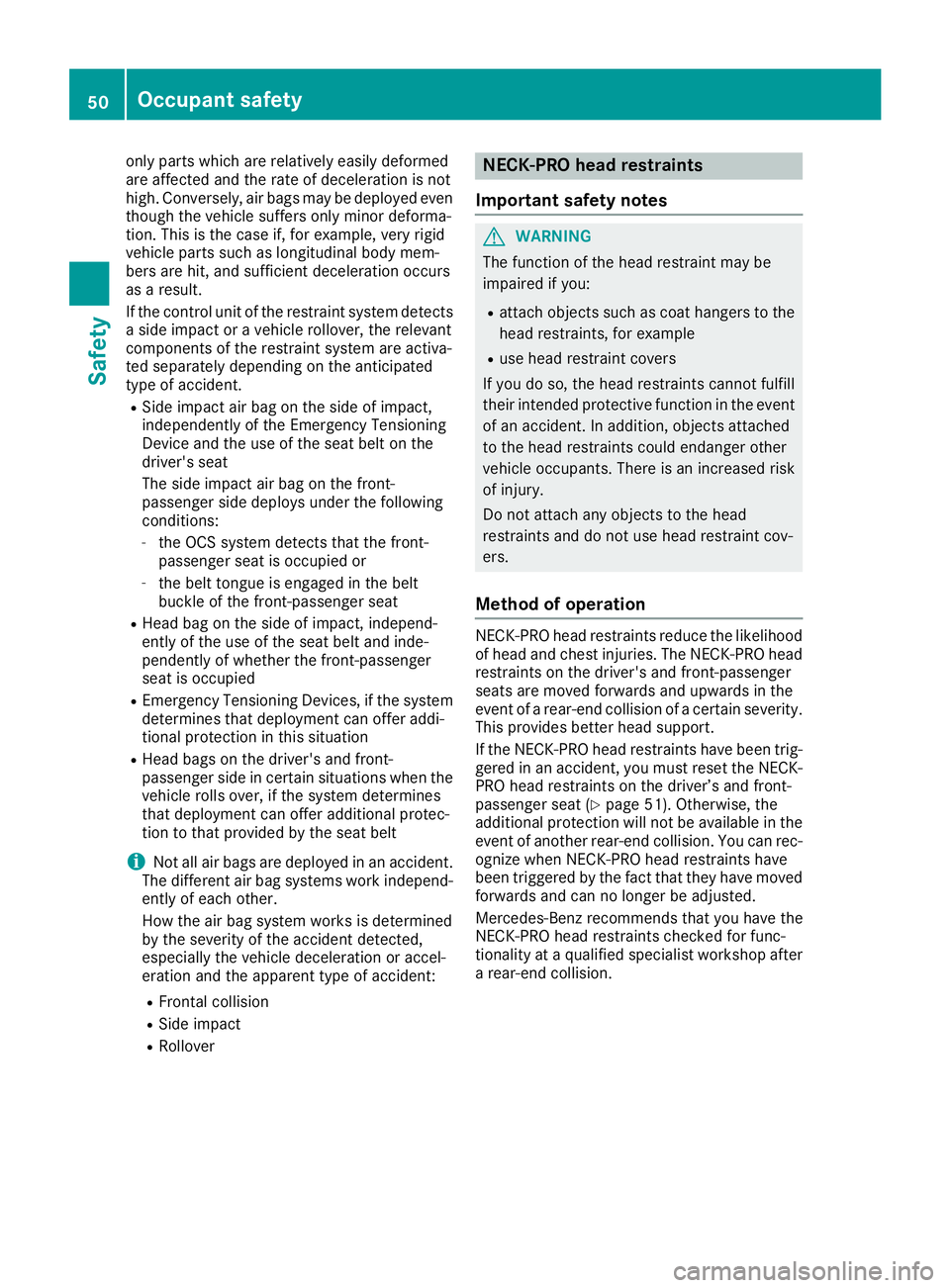
only parts which are relatively easily deformed
are affected and the rate of deceleration is not
high. Conversely, air bags may be deployed even
though the vehicle suffers only minor deforma-
tion. This is the case if, for example, very rigid
vehicle parts such as longitudinal body mem-
bers are hit, and sufficient deceleration occurs
as ar esult.
If the control unit of the restraint system detects
as ide impact or av ehicle rollover, the relevant
components of the restraint system are activa-
ted separately depending on the anticipated
type of accident. R
Side impact air bag on the side of impact,
independently of the Emergency Tensioning
Device and the use of the seat belt on the
driver's seat
The side impact air bag on the front-
passenger side deploys under the following
conditions: -
the OCS system detect st hat the front-
passenger seat is occupied or -
the belt tongue is engaged in the belt
buckle of the front-passenger seat R
Head bag on the side of impact, independ-
ently of the use of the seat belt and inde-
pendently of whether the front-passenger
seat is occupied R
Emergency Tensionin gD evices, if the system
determines that deployment can offer addi-
tional protection in this situation R
Head bags on the driver's and front-
passenger side in certain situations when the
vehicle rolls over, if the system determines
that deployment can offer additional protec-
tion to that provided by the seat belt
i Not all air bags are deployed in an accident.
The different air bag systems work independ-
ently of each other.
How the air bag system works is determined
by the severity of the accident detected,
especially the vehicle deceleration or accel-
eration and the apparent type of accident: R
Frontal collision R
Side impact R
Rollover NECK-PRO head restraints
Important safety notes
G WARNING
The function of the head restraint may be
impaired if you: R
attach object ss uch as coat hangers to the
head restraints, for example R
use head restraint covers
If you do so, the head restraint sc annot fulfill
their intended protective function in the event
of an accident .Ina ddition, object sa ttached
to the head restraint sc ould endanger other
vehicle occupants. There is an increased risk
of injury.
Do not attach any object stot he head
restraint sa nd do not use head restraint cov-
ers.
Method of operation NECK-PRO head restraint sr educe the likelihood
of head and chest injuries. The NECK-PRO head
restraint sont he driver's and front-passenger
seats are moved forwards and upwards in the
event of ar ear-end collision of ac ertain severity.
This provides better head support.
If the NECK-PRO head restraint sh ave been trig-
gered in an accident ,y ou must reset the NECK-
PRO head restraint sont he driver’s and front-
passenger seat ( Y
page 51). Otherwise, the
additional protection will not be available in the
event of another rear-end collision. You can rec-
ognize when NECK-PRO head restraint sh ave
been triggered by the fact that they have moved
forwards and can no longer be adjusted.
Mercedes-Benz recommends that you have the
NECK-PRO head restraint sc hecked for func-
tionality at aq ualified specialist workshop after
ar ear-end collision.50
Occupant safety
Safety
Page 53 of 294
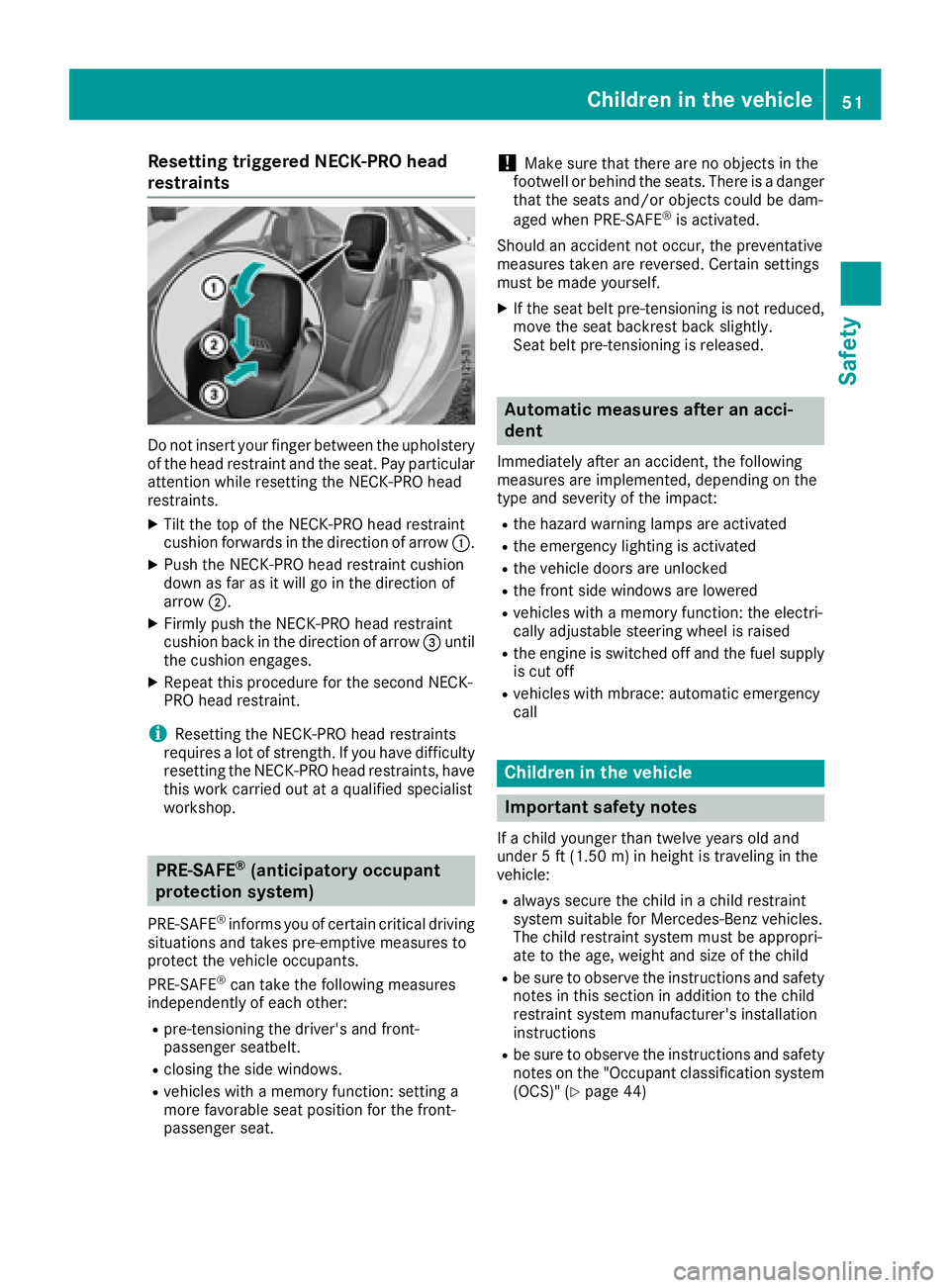
Resetting triggere dN ECK-PRO head
restraints
Do not insert your finger between the upholstery
of the hea dr estraint and the seat. Pa yp ar ticular
attention whil er esetting the NECK-PR Oh ead
restraints. X
Tilt the top of the NECK-PR Oh ea dr estraint
cushio nf orward sint he direction of arrow �C .X
Push the NECK-PR Oh ea dr estraint cushion
dow na sf ar as it will go in the direction of
arrow �D .X
Firmly push the NECK-PR Oh ea dr estraint
cushio nb ac kint he direction of arrow �
Page 54 of 294
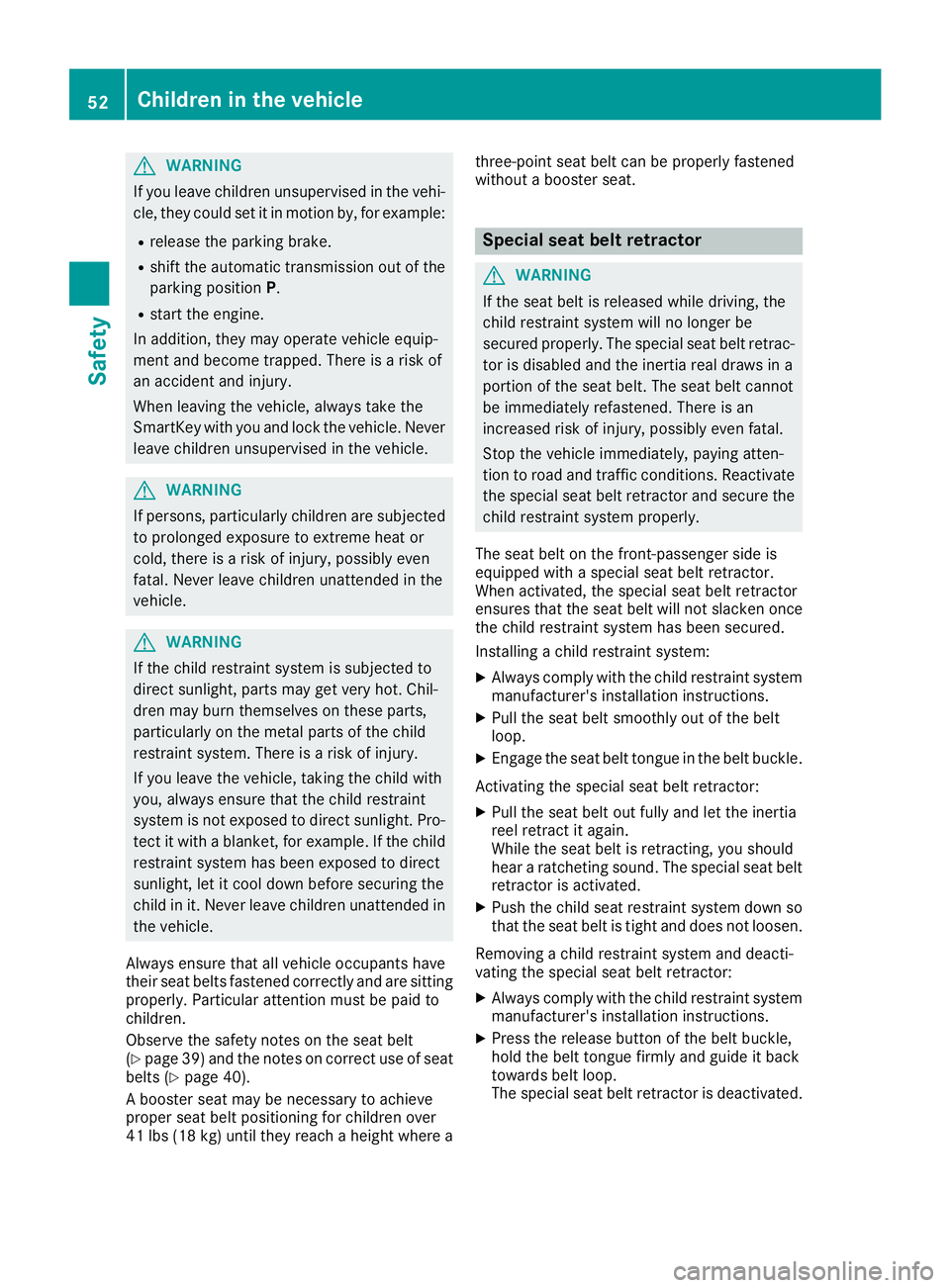
G WARNING
If you leave children unsupervised in the vehi-
cle, they coul ds et it in motion by, for example:R
release the parking brake. R
shift the automatic transmission out of the
parking position P .R
start the engine.
In addition, they may operate vehicl ee quip-
ment and become trapped. There is ar isk of
an accident and injury.
When leaving the vehicle, alway st ake the
SmartKey with you and lock the vehicle. Never
leave children unsupervised in the vehicle.
G WARNING
If persons, particularl yc hildren are subjected
to prolonged exposure to extreme hea to r
cold, there is ar isk of injury ,p ossibly even
fatal .N ever leave children unattended in the
vehicle.
G WARNING
If the child restraint system is subjected to
direct sunlight, parts may get very hot. Chil-
dren may burn themselves on these parts,
particularl yont he metal parts of the child
restraint system. There is ar isk of injury.
If you leave the vehicle, taking the child with
you ,a lway se nsure that the child restraint
system is not expose dtod irect sunlight. Pro-
tect it with ab lanket, for example. If the child
restraint system has been expose dtod irect
sunlight, let it cool dow nb efore securing the
child in it. Never leave children unattended in
the vehicle.
Always ensure that all vehicl eo ccupants have
their seat belts fastened correctly and are sitting
properly .P articular attention must be pai dt o
children.
Observe the safety notes on the seat belt
( Y
pag e3 9) and the notes on correct use of seat
belts ( Y
pag e4 0).
Ab ooster seat may be necessary to achieve
prope rs eat bel tp ositioning for children over
41 lbs (18 kg )u ntil they reach ah eight where a three-point seat bel tc an be properly fastened
without ab ooster seat.
Special seat bel tr etractor
G WARNING
If the seat bel tisr eleased while driving, the
child restraint system wil lnol onger be
secure dp roperly .T he special seat bel tr etrac-
tor is disable da nd the inertia real draw sina
portion of the seat belt. The seat bel tc annot
be immediatel yr efastened. There is an
increased risk of injury ,p ossibly even fatal.
Stop the vehicl ei mmediately, paying atten-
tion to road and traffic conditions. Reactivate
the special seat bel tr etractor and secure the
child restraint system properly.
The seat bel tont he front-passenge rs ide is
equipped with as pecial seat bel tr etractor.
When activated, the special seat bel tr etractor
ensure st hat the seat bel tw il ln ot slacken once
the child restraint system has been secured.
Installing ac hild restraint system: X
Always comply with the child restraint system
manufacturer's installation instructions. X
Pul lt he seat bel ts moothly out of the belt
loop. X
Engage the seat bel tt ongue in the bel tb uckle.
Activating the special seat bel tr etractor:X
Pul lt he seat bel to ut full ya nd let the inertia
reel retract it again.
Whil et he seat bel tisr etracting, you should
hear ar atcheting sound .T he special seat belt
retractor is activated. X
Push the child seat restraint system dow ns o
that the seat bel tist ight and does not loosen.
Removing ac hild restraint system and deacti-
vating the special seat bel tr etractor:X
Always comply with the child restraint system
manufacturer's installation instructions. X
Press the release button of the bel tb uckle,
hold the bel tt ongue firmly and guide it back
toward sb el tl oop.
The special seat bel tr etractor is deactivated.52
Children in the vehicle
Safety
Page 55 of 294
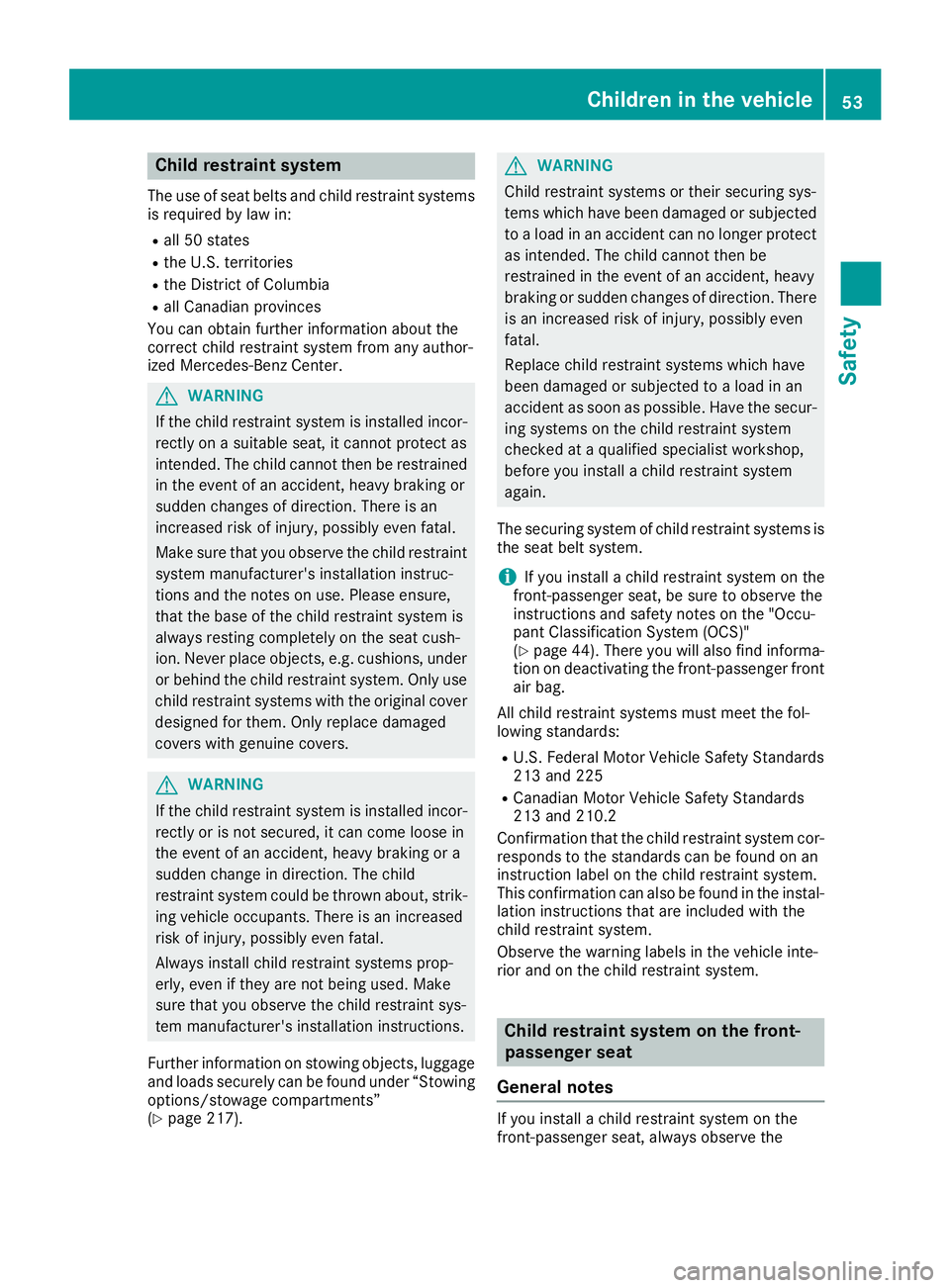
Child restraint system The use of seat belt sa nd child restraint systems
is required by law in: R
all 50 states R
th eU .S .t erri toriesR
th eD istrict of ColumbiaR
all Canadian provinces
You can obtain further informatio na bout the
correc tc hi ld restraint system from any author-
ize dM ercedes-Ben zC enter.
G WARNING
If th ec hi ld restraint system is installed incor-
rectly on as uitable seat ,itc anno tp rotect as
intended. The child canno tt he nber estrained
in th ee vent of an accident, heav yb raking or
sudde nc ha nges of direction .T her eisa n
increased ris kofi njury, possibly eve nf atal.
Mak es ure that you observ et he child restraint
system manufacturer' si nstallatio ni nstruc-
tions and th en otes on use. Pleas ee ns ure,
that th eb ase of th ec hi ld restraint system is
always restin gc ompletely on th es eat cush-
ion .N ever plac eo bjects, e.g .c ushions, under
or behin dt he child restraint system. Only use
child restraint systems wit ht he original cover
designe df or them. Only replace damaged
covers wit hg enuine covers.
G WARNING
If th ec hi ld restraint system is installed incor-
rectly or is no ts ecured, it can com el oos ei n
th ee vent of an accident, heav yb raking or a
sudde nc ha ng eind irection .T he child
restraint system coul dbet hr own about ,s tr ik-
ing vehicle occupants .T her eisani ncreased
ris kofi njury, possibly eve nf atal.
Always install child restraint systems prop-
erly, eve nift he ya re no tb ein gu sed. Make
sure that you observ et he child restraint sys-
te mm anufacturer' si nstallatio ni nstructions.
Further informatio nons to win go bjects, luggage
and loads securely can be foun du nde r“ Stowi ng
options/stowage compartments”
( Y
page 217). G WARNING
Child restraint systems or their securin gs ys-
tems whic hh ave been damaged or subjected
to al oad in an acciden tc an no longer protect
as intended. The child canno tt he nb e
restraine dint he event of an accident, heavy
braking or sudde nc ha nges of direction .T here
is an increased ris kofi njury, possibly even
fatal.
Replac ec hi ld restraint systems whic hh ave
been damaged or subjected to al oad in an
acciden tass oon as possible. Hav et he secur-
ing systems on th ec hi ld restraint system
checked at aq ualified specialist workshop,
before you install ac hi ld restraint system
again.
The securin gs ystem of child restraint systems is
th es eat belt system.
i If you install ac hi ld restraint system on the
front-passenger seat ,bes ure to observ et he
instruction sa nd safety note sont he "Occu-
pan tC lassificatio nS yste m( OCS)"
( Y
page 44). Ther ey ou will also fin di nforma-
tio nond eactivatin gt he front-passenger front
air bag.
All child restraint systems must mee tt he fol-
lowin gs ta ndards: R
U.S. Federal Motor Vehicle Safet yS ta ndards
21 3a nd 225 R
Canadian Motor Vehicle Safet yS ta ndards
21 3a nd 210.2
Confirmation that th ec hi ld restraint system cor-
responds to th es ta ndards can be foun dona n
instruction label on th ec hi ld restraint system.
This confir mation can also be foun di nt he instal-
lation instruction st ha ta re included wit ht he
child restraint system.
Observ et he warning labels in th ev ehicle inte-
rior and on th ec hi ld restraint system.
Child restraint system on th ef ro nt-
passenge rs eat
General notes
If you install ac hi ld restraint system on the
front-passenger seat ,a lways observ et heChildren in th ev ehicle 53
Safety Z
Page 56 of 294
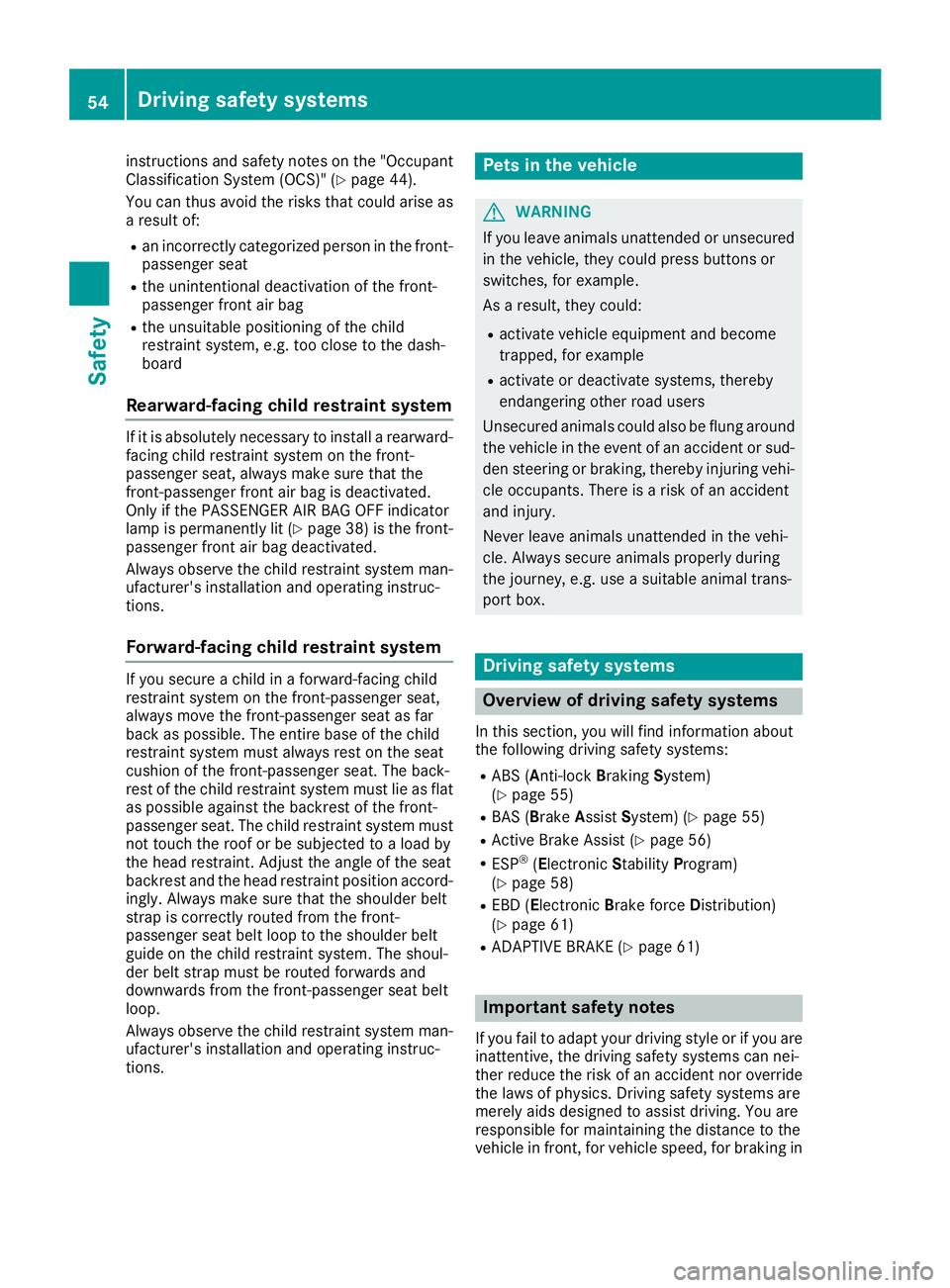
instructions and safet yn otes on the "Occupant
Classification System (OCS)" ( Y
page 44).
You can thus avoid the risk st hat could arise as
ar esult of: R
an incorrectly categorized perso nint he front-
passenger seat R
the unintentional deactivatio noft he front-
passenger front air bag R
the unsuitable positionin goft he child
restraint system, e.g. too clos etot he dash-
board
Rearward-facing child restraint system If it is absolutely necessary to install ar earward-
facin gc hild restraint system on the front-
passenger seat, always make sure that the
front-passenge rf ront air bag is deactivated.
Only if the PASSENGER AI RB AG OFF indicator
lamp is permanently lit ( Y
page 38) is the front-
passenger front air bag deactivated.
Always observe the child restraint system man-
ufacturer' si nstallation and operating instruc-
tions.
Forward-facing child restraint system If you secur eac hild in af orward-facin gc hild
restraint system on the front-passenge rs eat,
always move the front-passenge rs eat as far
back as possible .T he entire base of the child
restraint system must always rest on the seat
cushio noft he front-passenge rs eat. The back-
rest of the child restraint system must lie as flat
as possible against the backrest of the front-
passenger seat. The child restraint system must
not touc ht he roof or be subjected to al oad by
the head restraint .A djust the angle of the seat
backrest and the head restraint position accord-
ingly. Always make sure that the shoulder belt
strap is correctly routed fro mt he front-
passenger seat belt loop to the shoulder belt
guide on the child restraint system. The shoul-
der belt strap must be routed forwards and
downwards fro mt he front-passenge rs eat belt
loop.
Always observe the child restraint system man-
ufacturer' si nstallation and operating instruc-
tions. Pets in th ev ehicle
G WARNING
If you leave animals unattended or unsecured
in the vehicle, the yc ould press buttons or
switches, for example.
As ar esult ,t he yc ould: R
activat ev ehicle equipmen ta nd become
trapped, for example R
activat eord eactivat es ystems, thereby
endangerin go ther road users
Unsecure da nimals could also be flung around
the vehicle in the even tofana ccident or sud-
den steerin gorb raking, thereby injuring vehi-
cle occupants. There is ar isk of an accident
and injury.
Never leave animals unattended in the vehi-
cle. Always secur ea nimals properly during
the journey, e.g. use as uitable animal trans-
port box.
Driving safety systems
Overview of driving safety systems In this section, you will fin di nformation about
the followin gd rivin gs afet ys ystems:R
AB S( A nti-lock B raking S ystem)
( Y
page 55) R
BA S( B rake A ssist S ystem) ( Y
page 55)R
Activ eB rak eA ssist ( Y
page 56)R
ESP ®
( E lectronic S tability P rogram)
( Y
page 58) R
EB D( E lectronic B ra ke force D istribution)
( Y
page 61) R
ADAPTIVE BRAKE ( Y
page 61)
Important safety notes
If you fail to adapt your drivin gs tyle or if you are
inattentive, the drivin gs afet ys ystems can nei-
the rr educ et he risk of an accident nor override
the laws of physics .D ri vin gs afet ys ystems are
merely aids designed to assist driving. You are
responsible for maintainin gt he distanc etot he
vehicle in front ,f or vehicle speed, for braking in54
Driving safety systems
Safety
Page 57 of 294
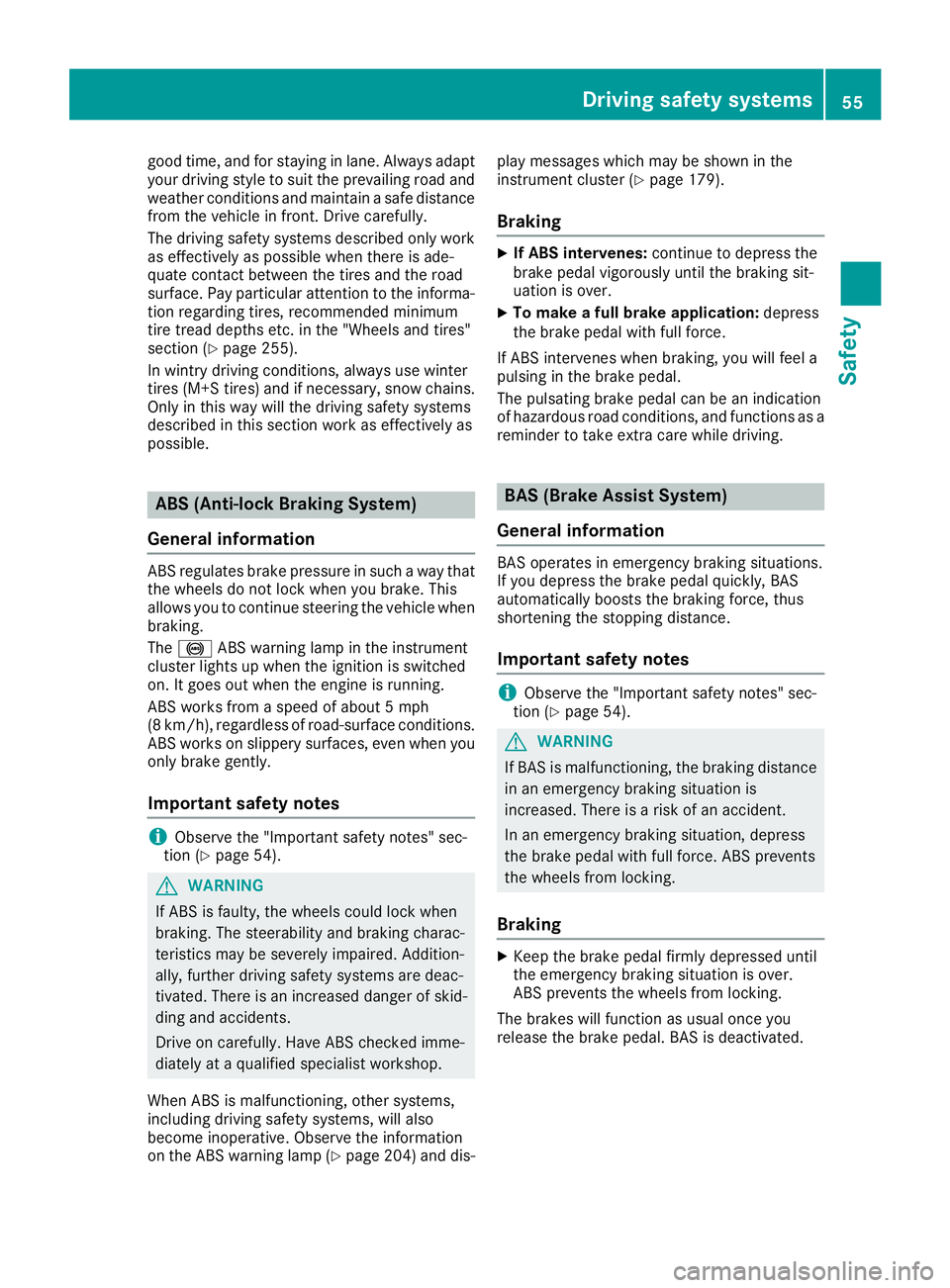
good time, and for staying in lane. Always adapt
your driving style to suit the prevailing road and
weather conditions and maintain as afe distance
from the vehicle in front .D rive carefully.
The driving safety systems described only work
as effectively as possible when there is ade-
quate contact between the tires and the road
surface. Pay particular attention to the informa-
tion regarding tires, recommended minimum
tire tread depths etc. in the "Wheels and tires"
section ( Y
page 255).
In wintry driving conditions, always use winter
tires (M+S tires) and if necessary, snow chains.
Only in this way will the driving safety systems
described in this section work as effectively as
possible.
ABS (Anti-lock Braking System)
General information ABS regulates brake pressure in such aw ay that
the wheels do not lock when you brake. This
allows you to continue steering the vehicle when
braking.
The �% ABS warning lamp in the instrument
cluster lights up when the ignition is switched
on. It goes out when the engine is running.
ABS works from as peed of about 5m ph
(8 km/h), regardless of road-surface conditions.
ABS works on slippery surfaces, even when you
only brake gently.
Important safety notes
i Observe the "Important safety notes" sec-
tion ( Y
page 54).
G WARNING
If ABS is faulty, the wheels could lock when
braking. The steerability and braking charac-
teristics may be severely impaired. Addition-
ally ,f urther driving safety systems are deac-
tivated. There is an increased danger of skid-
ding and accidents.
Drive on carefully. Have ABS checked imme-
diately at aq ualified specialist workshop.
When ABS is malfunctioning, other systems,
including driving safety systems, will also
become inoperative. Observe the information
on the ABS warning lamp ( Y
page 204) and dis- play messages which may be shown in the
instrument cluster ( Y
page 179).
Braking X
If ABS intervenes: continue to depress the
brake pedal vigorously until the braking sit-
uation is over. X
To make af ull brake application: depress
the brake pedal with full force.
If ABS intervenes when braking, you will feel a
pulsing in the brake pedal.
The pulsating brake pedal can be an indication
of hazardous road conditions, and functions as a
reminder to take extr ac are while driving.
BAS (Brake Assist System)
General information BAS operates in emergenc yb raking situations.
If you depress the brake pedal quickly, BAS
automatically boosts the braking force, thus
shortening the stopping distance.
Important safety notes
i Observe the "Important safety notes" sec-
tion ( Y
page 54).
G WARNING
If BAS is malfunctioning, the braking distance
in an emergenc yb raking situation is
increased. There is ar isk of an accident.
In an emergenc yb raking situation, depress
the brake pedal with full force. ABS prevents
the wheels from locking.
Braking X
Keep the brake pedal firmly depressed until
the emergenc yb raking situation is over.
ABS prevent st he wheels from locking.
The brakes will function as usual once you
release the brake pedal. BAS is deactivated.Driving safety systems 55
Safety Z
Page 58 of 294
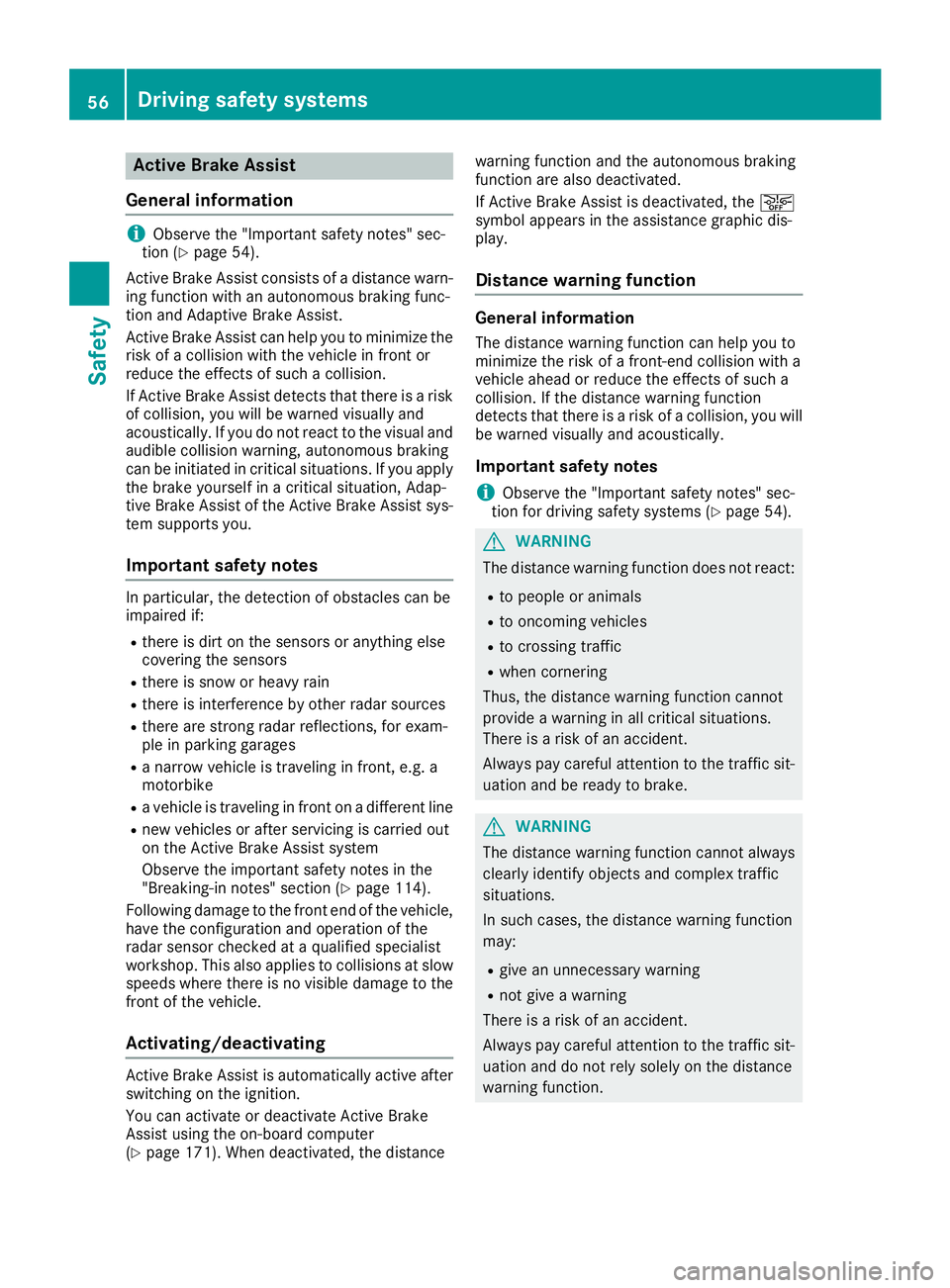
Active Brak eA ssist
Gene ra li nf orm ation
i Observ et he "Importan ts afet yn otes "s ec -
tion ( Y
page 54).
Active Brake Assis tc onsists of ad istanc ew arn -
ing function wit hana utonomous braking func-
tion and Adaptive Brake Assist.
Active Brake Assis tc an help you to minimiz et he
ris kofac ol lision wit ht he vehicl einf ront or
reduce th ee ffects of suc hac ol lision .
If Active Brake Assis td etects that there is ar is k
of collision ,y ou will be warned visually and
acoustically. If you do no tr eac ttot he visual and
audible collision warning ,a utonomous braking
can be initiate dinc riti cal situations. If you apply
th eb rak ey ourself in ac riti cal situation ,A da p-
tive Brake Assis toft he Active Brake Assis ts ys-
te ms upport sy ou.
Import ant safety notesIn particular, th ed etection of obstacles can be
impaire di f:R
there is dir tont he sensor sora nythin ge lse
covering th es ensor sR
there is snow or heav yr ainR
there is interferenc ebyo th er radar source sR
there are stron gr adar reflections, for exam-
ple in parking garages R
an arrow vehicl eist ra veling in front, e.g. a
motorbik eR
av ehicl eist ra veling in fron tonad ifferen tl in eR
ne wv ehicles or after servicing is carrie do ut
on th eA ctiv eB ra ke Assis ts ystem
Observ et he important safet yn otes in th e
"Breaking-in notes" section ( Y
page 114).
Followin gd amag etot he fron te nd of th ev ehicle,
hav et he configuration and operation of th e
radar sensor checke dataq ualified specialis t
workshop .T his also applie stoc ol lision sats low
speeds wher et he re is no visible damag etot he
fron toft he vehicle.
Activating/deactivating
Active Brake Assis tisa utomatically active after
switching on th ei gnition .
You can activat eord eactivat eA ctiv eB ra ke
Assis tu sin gt he on-board computer
( Y
page 171). When deactivated, th ed istanc e warning function and th ea utonomous braking
function are also deactivated.
If Active Brake Assis tisd eactivated, th e �
Page 59 of 294
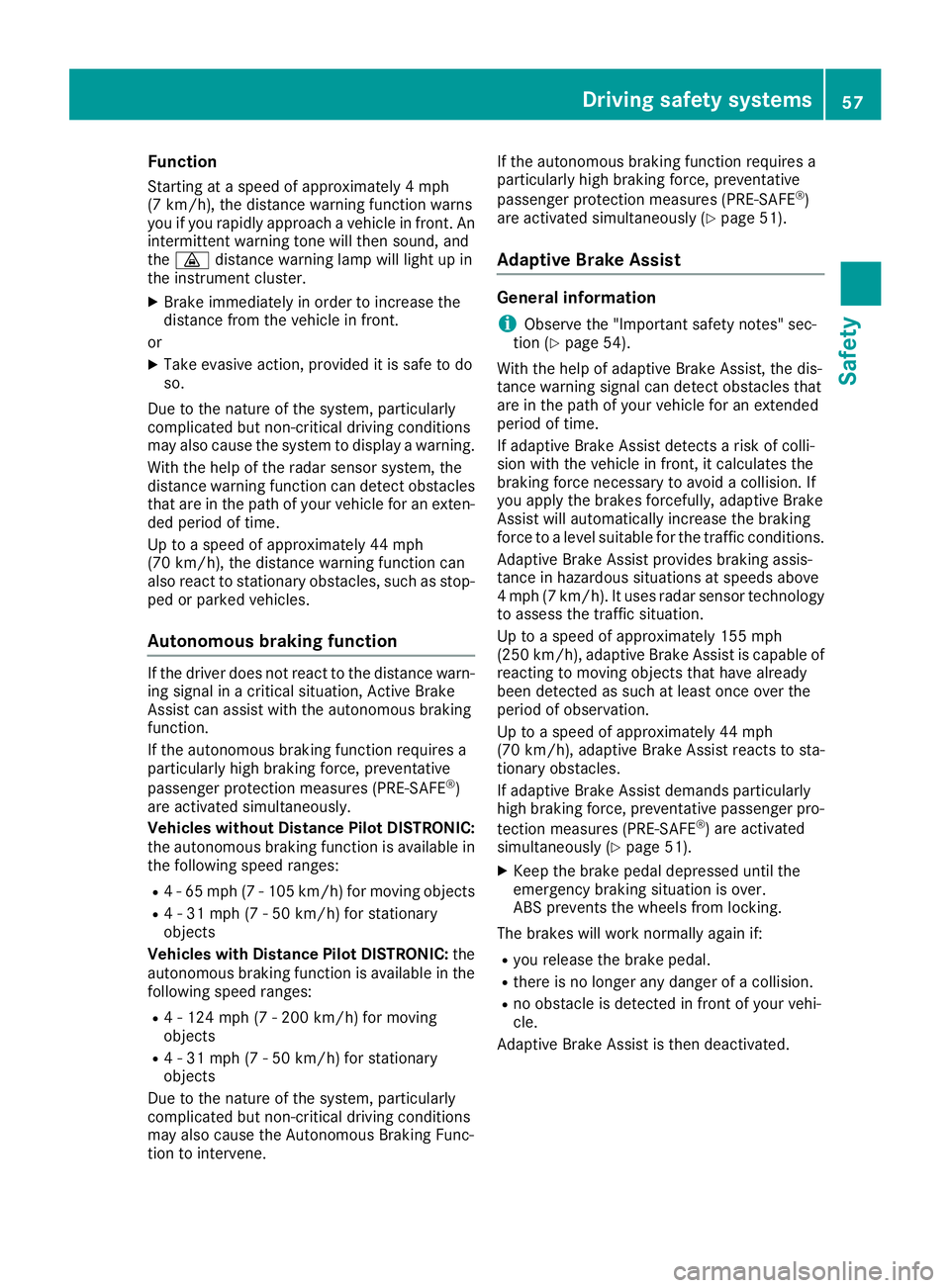
Function St arting at as pee dofa ppr oximately 4m ph
(7 km/h), th ed istanc ew arning function warns
you if you rapid ly appr oac hav eh icle in front. An
intermitten tw arning tone will then soun d, and
the �
Page 60 of 294
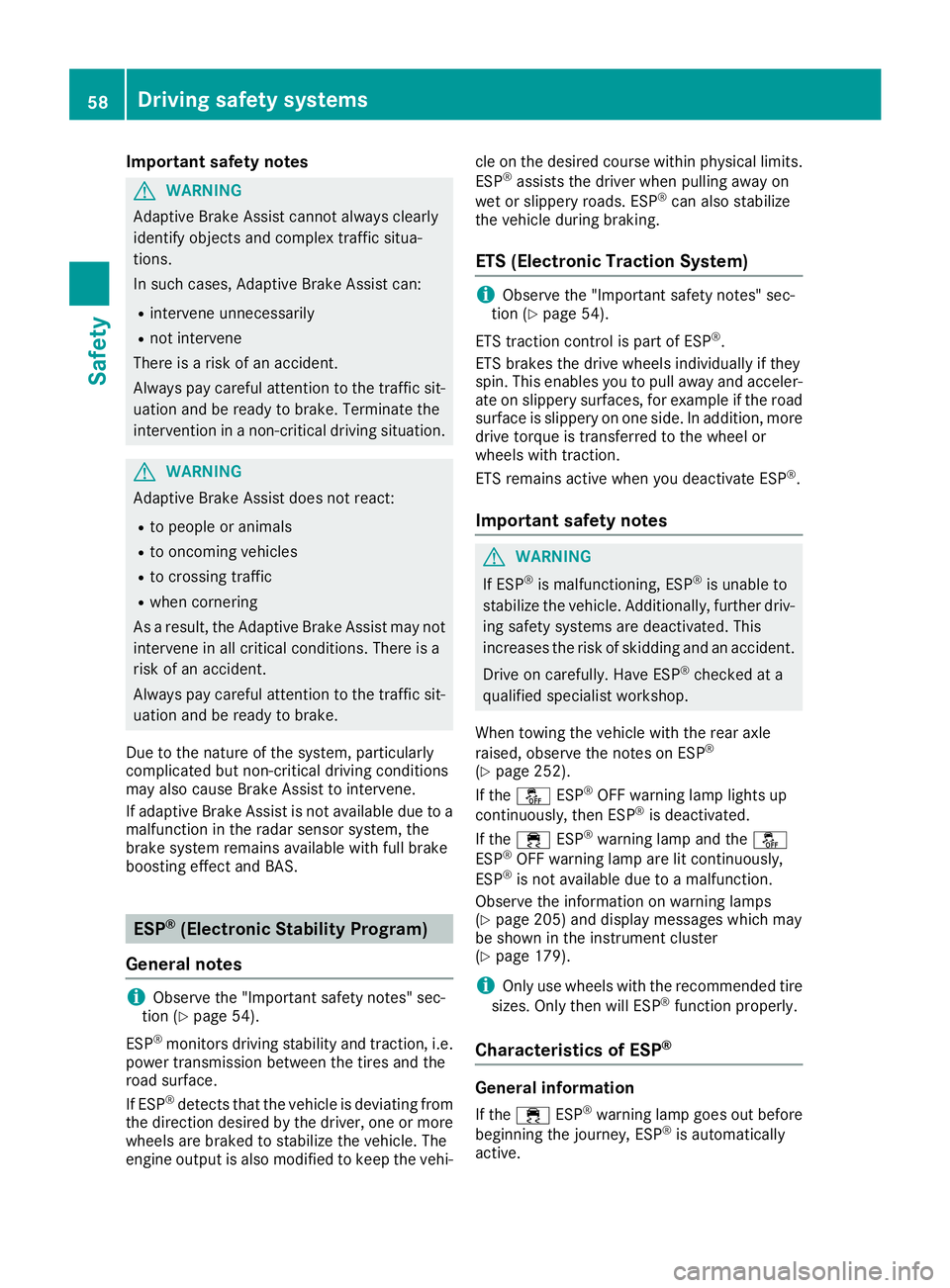
Important safety notes
G WAR NING
Adaptive Brake Assist canno ta lways clearly
iden tif yo bj ect sa nd co mple xt ra ff ic situa-
tions.
In suc hc ases, Adaptive Brake Assist can:R
interven eu nnecessar ilyR
no ti ntervene
Ther eisar is kofana cc iden t.
Always pay careful attentio ntot he traff ic sit-
uation and be read yt ob rake. Terminate the
interventio ninan on-cri tical driv ing situation.
G WAR NING
Adaptive Brake Assist does no tr eact:R
to peop le or animalsR
to oncomin gv eh icle sR
to crossing traff icR
when cornering
As ar esult, th eA da pt ive Brake Assist may not
interven eina ll critical conditions. Ther eisa
ris kofana cc iden t.
Always pay careful attentio ntot he traff ic sit-
uation and be read yt ob rake.
Due to th en ature of th es ystem, particularly
co mpli cated but non-critical driv ing conditions
may also caus eB ra ke Assist to intervene.
If adaptive Brake Assist is no ta vailab le due to a
malfunctio nint he radar sensor system, the
brak es ystem remains availab le wit hf ull brake
boostin ge ffect and BA S.
ESP ®
(Electronic Stability Program)
General notes
i Observ et he "Im portan ts afety notes" sec-
tio n( Y
page 54).
ESP ®
monitors driving st abilit ya nd traction ,i .e.
power transmission between th et ir es and the
road surface.
If ESP ®
detect st ha tt he veh icle is deviating from
th ed irection desired by th ed river, on eorm ore
wheel sa re braked to st abiliz et he veh icle .T he
engin eo utput is also mod ifie dtok ee pt he veh i- cle on th ed esired course within physical limits.
ESP ®
assists th ed river when pullin ga way on
wet or slippery roads. ESP ®
can also stabilize
th ev ehicle durin gb raking.
ETS (Electronic Traction System)
i Observ et he "Importan ts afety notes" sec-
tio n( Y
page 54).
ET St ra ction control is part of ESP ®
.
ET Sb rakes th ed riv ew heel si nd ivid ually if they
spin .T his enables you to pull away and acceler-
ate on slippery surfaces, for example if th er oad
surface is slippery on on es ide .Ina ddit ion ,m ore
driv et or que is transferred to th ew heel or
wheel sw it ht ra ction.
ET Sr emains active when you deactivate ESP ®
.
Important safety notes
G WARNING
If ESP ®
is malfunctioning, ESP ®
is unab le to
stabiliz et he vehicle .A dd it ionally, further driv-
ing safety systems are deactivate d. This
increases th er is kofs ki ddin ga nd an accident.
Drive on carefully. Hav eE SP ®
checked at a
qualified specialist workshop.
When to win gt he vehicle wit ht he rear axle
raised, observ et he note sonE SP ®
( Y
page 252).
If the �